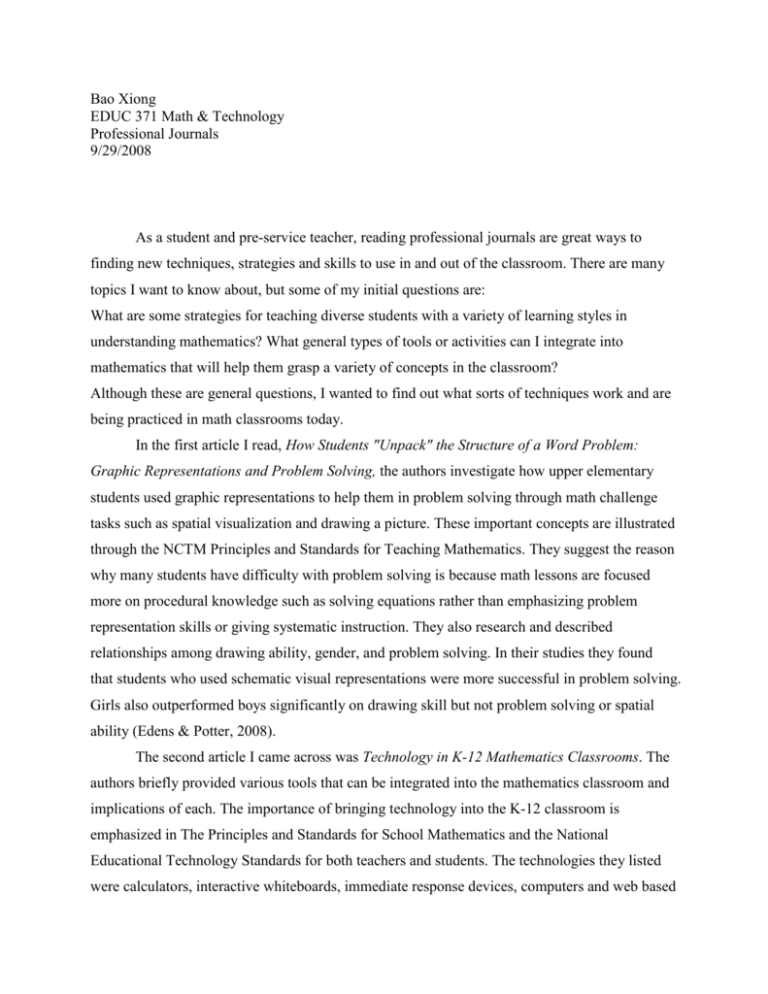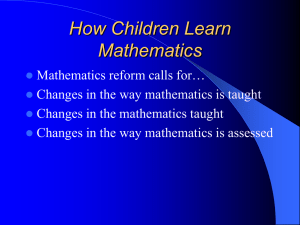What are some strategies for helping students
advertisement

Bao Xiong EDUC 371 Math & Technology Professional Journals 9/29/2008 As a student and pre-service teacher, reading professional journals are great ways to finding new techniques, strategies and skills to use in and out of the classroom. There are many topics I want to know about, but some of my initial questions are: What are some strategies for teaching diverse students with a variety of learning styles in understanding mathematics? What general types of tools or activities can I integrate into mathematics that will help them grasp a variety of concepts in the classroom? Although these are general questions, I wanted to find out what sorts of techniques work and are being practiced in math classrooms today. In the first article I read, How Students "Unpack" the Structure of a Word Problem: Graphic Representations and Problem Solving, the authors investigate how upper elementary students used graphic representations to help them in problem solving through math challenge tasks such as spatial visualization and drawing a picture. These important concepts are illustrated through the NCTM Principles and Standards for Teaching Mathematics. They suggest the reason why many students have difficulty with problem solving is because math lessons are focused more on procedural knowledge such as solving equations rather than emphasizing problem representation skills or giving systematic instruction. They also research and described relationships among drawing ability, gender, and problem solving. In their studies they found that students who used schematic visual representations were more successful in problem solving. Girls also outperformed boys significantly on drawing skill but not problem solving or spatial ability (Edens & Potter, 2008). The second article I came across was Technology in K-12 Mathematics Classrooms. The authors briefly provided various tools that can be integrated into the mathematics classroom and implications of each. The importance of bringing technology into the K-12 classroom is emphasized in The Principles and Standards for School Mathematics and the National Educational Technology Standards for both teachers and students. The technologies they listed were calculators, interactive whiteboards, immediate response devices, computers and web based applications which included descriptions and benefits of each technology. These picks were of particular interest because of their effects on instruction and student learning (Ozel et. al, 2008). I found these articles to be useful in helping me understand some ways I can be creative in the classroom and break-away from traditional learning strategies that maybe aren’t as effective. For example, one of the technologies they listed was the “immediate response devices” also known as clickers which promote active learning in mathematics by enabling the teacher to integrate questioning and classroom discussions with immediate response from every student. There are many uses for it, for example taking attendance, class polls/opinions, quizzes) and I think it’s great because not only do they get immediate feedback from the teacher, but there is a feature which lets responses remain anonymous if needed as well as the feature of a “game approach” which draws the student’s attention by engaging them in something fun while learning at the same time! This is definitely something I’ve never heard of before and would love to try out. When I came across it, I was reminded of the history quiz game show at the Minnesota History Museum where I played while visiting this past summer with my summer school students. After learning about the history of Minnesota on our brief tour, we sat down and played by buzzing in our answers to the multiple choice questions on the screen. We had so much fun we didn’t want to leave. I remember thinking to myself, “what if we could have something like that in the classroom? The students would just love it!” The article about graphic representations was also intriguing because the visual-spatial thinking skill is valuable and important in mathematics. I know imagery does play an important role in all of our thought processes and one important process of the problem solving cycle is the ability to make a meaningful representation. The authors discussed a small study of subjects which performed the ‘rotation task’ which subjects were asked to determine whether two perspective drawings of 3-dimensional objects were the same or different which “evidence suggested that the ability to spatially visualize three-dimensionally in the mind's eye has been an indicator of educational success in many fields, particularly science, mathematics, architecture, and other engineering and technology professions.” (Edens & Potter, 2008) These articles gave me valuable ideas on how to use a variety of strategies in the classroom. What’s great about these versatile strategies is that they can easily be integrated together. As a teacher, you could use technology to teach ways to make representations. The authors noted that the two ways to best assist students in using the visual representation skills is by teaching students specific types of diagrams or teaching them to make drawings of their own. For example, visual-spatial representations can be developed through the use of technology through the many software packages or interactive websites that allow you to create sketches, diagrams and drawings such as Inspiration 8 or Kidspiration 3. I think it’s important that these are included in the national standards because we need to teach students to develop and use a variety of representations to serve as tools for thinking about and solving problems. As a preservice teacher, it’s important to understand the students we have today are quite different from the students we were then. A decade doesn’t seem to be that long ago, but new research and studies are constantly finding new and improved ways of how to teach and how students learn. We are also in an information and technology age which means we should integrate technology to enhance student learning as much as possible. These are great ideas to keep in mind for my future classroom because there are so many ways these strategies and technologies can be used for math and all of the other subjects. Research has shown that technology isn’t really woven into the teaching and learning process. Factors such as accessibility, technical support and technical support can deter teachers from incorporating technology into the classroom. Although many schools lack the appropriate technical support or some teachers experience technology failure in their classrooms and give up, I know I will try different methods for integrating diverse technologies into classrooms and utilize technology into the curriculum to accommodate different learning styles. Sources: Edens, K., et. al., How Students "Unpack" the Structure of a Word Problem: Graphic Representations and Problem Solving. School Science and Mathematics v. 108 no. 5 (May 2008) p. 184-96 Ozel, S., et. al., Technology in K-12 Mathematics Classrooms. School Science and Mathematics 108 no. 2 (Fall 2008) p. 80-5





